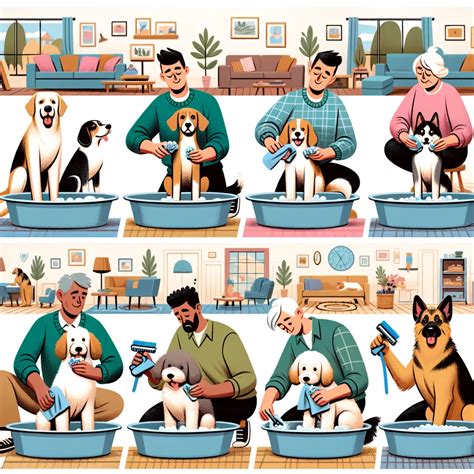
Cats exhibit a wide range of reactions to head “boops,” ranging from affectionate purrs and nuzzles to clear signs of annoyance, as demonstrated in a viral video showcasing diverse feline responses.
A recent viral video circulating online has ignited a discussion among cat lovers regarding the varying reactions cats display when subjected to the endearing act of a head “boop.” The video, highlighted on Yahoo Lifestyle, reveals that while some cats respond positively with purrs, head nuzzles, and affectionate gestures, others exhibit clear signs of displeasure, suggesting that not all felines appreciate this form of interaction. This observation underscores the importance of understanding individual feline personalities and respecting their boundaries when it comes to physical affection.
The video, which quickly gained traction across various social media platforms, features a compilation of clips showing cats being “booped” on the head. The reactions are strikingly diverse. Some cats immediately lean into the touch, purring contentedly and rubbing their faces against the hand initiating the “boop.” These cats appear to interpret the gesture as a sign of affection and respond in kind. However, other cats in the video display markedly different behaviors. They may flinch, pull away, or even exhibit subtle signs of aggression, such as flattened ears or a twitching tail. These reactions suggest that these cats find the head “boop” to be an unwelcome intrusion.
Animal behaviorists suggest that understanding the context of the interaction and the individual cat’s personality is crucial in interpreting these varying responses. A cat’s reaction to a head “boop” can be influenced by several factors, including its relationship with the person initiating the touch, its current mood, and its past experiences with physical interaction. For instance, a cat that has been socialized from a young age to enjoy human contact is more likely to respond positively to a head “boop” than a cat that is more independent or has had negative experiences with being touched.
Furthermore, the manner in which the “boop” is administered can also play a significant role. A gentle, slow approach is more likely to be well-received than a sudden, forceful touch. Cats are highly sensitive creatures, and they can easily become startled or overwhelmed by abrupt movements or loud noises. Therefore, it is essential to approach a cat calmly and respectfully, allowing it to initiate the interaction if it so chooses.
The viral video serves as a reminder that cats, despite their reputation for independence, are complex animals with distinct personalities and preferences. While some cats may enjoy being petted and cuddled, others may prefer to keep their distance. It is up to cat owners and enthusiasts to learn to recognize and respect these individual differences. By paying close attention to a cat’s body language and behavior, we can better understand its needs and preferences, and foster a more positive and harmonious relationship.
One key aspect of understanding feline behavior is recognizing the subtle cues that cats use to communicate their feelings. A cat’s body language can provide valuable insights into its mood and intentions. For example, a cat that is relaxed and content will typically have its ears forward, its eyes half-closed, and its tail held loosely. On the other hand, a cat that is feeling threatened or anxious may have its ears flattened, its eyes wide, and its tail tucked between its legs.
Similarly, a cat’s vocalizations can also provide clues to its emotional state. Purring is often associated with contentment, but it can also indicate that a cat is feeling stressed or anxious. Meowing is another common form of feline communication, and it can be used to express a variety of needs and desires, such as hunger, attention, or a request to be let outside.
By observing these subtle cues, cat owners can gain a better understanding of their feline companions’ needs and preferences. This, in turn, can help to create a more positive and enriching environment for the cat, and strengthen the bond between owner and pet.
The Yahoo Lifestyle article also highlights the importance of respecting a cat’s boundaries. Just as humans have personal space, so too do cats. Forcing a cat to endure unwanted physical contact can lead to stress, anxiety, and even aggression. It is essential to allow a cat to approach you on its own terms, and to respect its decision if it chooses to keep its distance.
One way to gauge a cat’s comfort level is to offer your hand and allow it to sniff you. If the cat rubs against your hand, it is likely indicating that it is comfortable with being touched. However, if the cat pulls away or hisses, it is best to respect its boundaries and avoid initiating physical contact.
Another important consideration is the location on the cat’s body where you are attempting to touch it. Some cats are more sensitive to being touched in certain areas than others. For example, many cats enjoy being scratched under the chin or behind the ears, but they may not appreciate being touched on their belly or tail.
By being mindful of these factors, cat owners can ensure that their interactions with their feline companions are positive and enjoyable for both parties. Ultimately, the key to a successful relationship with a cat is to respect its individuality and to allow it to express its preferences freely.
The viral video and the discussion it has sparked underscore the importance of responsible pet ownership. Owning a cat is not simply about providing food and shelter; it is also about understanding and respecting its needs and preferences. By taking the time to learn about feline behavior and communication, cat owners can create a more fulfilling and harmonious relationship with their pets.
Moreover, it is important to remember that every cat is an individual, and what works for one cat may not work for another. Some cats may thrive on attention and affection, while others may prefer a more independent lifestyle. The key is to observe your cat’s behavior and to adjust your interactions accordingly.
In addition to understanding a cat’s individual personality, it is also important to provide it with a stimulating and enriching environment. Cats are naturally curious and playful creatures, and they need opportunities to exercise their minds and bodies. This can be achieved by providing them with toys, scratching posts, and climbing structures.
Furthermore, it is important to ensure that a cat has access to a safe and comfortable space where it can retreat and relax when it feels overwhelmed or stressed. This could be a quiet corner of the house, a comfortable bed, or even a cardboard box.
By providing a stimulating and enriching environment, cat owners can help to ensure that their feline companions are happy, healthy, and well-adjusted. This, in turn, can lead to a stronger and more fulfilling bond between owner and pet.
The ongoing discussion about cat behavior and preferences highlights the importance of ongoing research in the field of animal behavior. Scientists are constantly learning more about the complex ways in which animals communicate and interact with their environment. This knowledge can be invaluable in helping us to better understand and care for our pets.
One area of ongoing research is the study of feline communication. Scientists are working to decipher the subtle cues that cats use to communicate their feelings, such as their body language, vocalizations, and scent markings. This research could lead to new and improved methods for understanding and responding to a cat’s needs.
Another area of research is the study of feline cognition. Scientists are investigating the cognitive abilities of cats, such as their problem-solving skills, their memory, and their ability to learn. This research could help us to better understand how cats perceive the world around them, and how we can best provide them with the stimulation and enrichment they need.
By supporting and encouraging ongoing research in the field of animal behavior, we can help to improve the lives of cats and other animals around the world. This research can provide us with the knowledge and tools we need to better understand and care for our pets, and to foster more positive and harmonious relationships with them.
The viral video of cats reacting to head “boops” has sparked a lively debate among cat owners and enthusiasts. While some people argue that head “boops” are a harmless and affectionate gesture, others believe that they can be intrusive and disrespectful. Ultimately, the decision of whether or not to “boop” a cat’s head is a personal one, and it should be based on a thorough understanding of the individual cat’s personality and preferences.
However, regardless of one’s personal opinion on the matter, the video serves as a valuable reminder that cats are complex and sensitive creatures, and that they should be treated with respect and understanding. By taking the time to learn about feline behavior and communication, we can create a more positive and fulfilling relationship with our feline companions.
Frequently Asked Questions (FAQ)
1. Why do some cats like head “boops” while others don’t?
Cats have individual personalities and preferences, just like humans. Some cats are naturally more affectionate and enjoy physical contact, while others are more independent and prefer to keep their distance. A cat’s reaction to a head “boop” can also be influenced by factors such as its relationship with the person initiating the touch, its current mood, and its past experiences with physical interaction. As stated in the Yahoo Lifestyle article, “understanding the context of the interaction and the individual cat’s personality is crucial in interpreting these varying responses.” A cat that has been socialized from a young age to enjoy human contact is more likely to respond positively than one that is more independent.
2. How can I tell if my cat enjoys being “booped” on the head?
Pay attention to your cat’s body language. If your cat leans into the touch, purrs, rubs its face against your hand, or exhibits other signs of contentment, it is likely enjoying the interaction. However, if your cat flinches, pulls away, flattens its ears, twitches its tail, or shows any other signs of discomfort, it is best to stop and respect its boundaries. Observation is key, and, as the article implies, understanding subtle cues can lead to better interactions.
3. Is there a “right” way to “boop” a cat’s head?
If you choose to “boop” your cat’s head, do so gently and slowly. Avoid sudden or forceful movements, as these can startle or overwhelm the cat. It is also important to approach the cat calmly and respectfully, allowing it to initiate the interaction if it so chooses. “A gentle, slow approach is more likely to be well-received than a sudden, forceful touch,” notes the underlying principle of positive interaction highlighted in the source material.
4. What are some other ways to show affection to my cat besides head “boops”?
There are many ways to show affection to your cat that do not involve physical touch. You can talk to your cat in a soft and gentle voice, play with it using toys, provide it with a comfortable place to sleep, and ensure that it has access to fresh food and water. You can also simply spend time with your cat, allowing it to be in your presence without demanding attention. Every cat is different, and it is important to find the ways that work best for you and your feline companion. The article stresses creating an enriching environment and allowing the cat to express their preferences freely.
5. What if my cat consistently reacts negatively to any form of physical touch?
Some cats simply do not enjoy being touched, regardless of the manner in which it is administered. If your cat consistently reacts negatively to physical touch, it is important to respect its boundaries and avoid forcing it to endure unwanted contact. This does not mean that you cannot have a close and loving relationship with your cat; it simply means that you need to find other ways to connect with it, such as through play, verbal communication, and providing it with a comfortable and stimulating environment. The overarching message from the viral video and subsequent discussions emphasizes respecting a cat’s individuality and preferences.
The diverse reactions to head “boops” underscore the complex nature of feline behavior and the importance of individualized approaches to interacting with cats. While the viral video provides anecdotal evidence, the underlying message is consistent with established principles of animal behavior: understanding and respecting individual animal preferences is crucial for fostering positive relationships. This applies not only to head “boops” but to all forms of interaction with cats, highlighting the need for owners to be observant, responsive, and respectful of their feline companions’ needs and boundaries. The discussion extends beyond mere entertainment, serving as a practical lesson in responsible pet ownership and the nuanced dynamics of human-animal interaction.
The discussion surrounding head “boops” can also be framed within the broader context of animal welfare. While a simple “boop” might seem harmless, the cumulative effect of unwanted or misinterpreted interactions can contribute to stress and anxiety in cats, potentially impacting their overall well-being. Recognizing and addressing these subtle signs of discomfort is a key aspect of responsible pet ownership and aligns with ethical considerations regarding animal care. By prioritizing the animal’s comfort and agency, owners can promote a more positive and enriching environment, fostering a stronger bond built on mutual respect and understanding. This perspective emphasizes the proactive role of owners in ensuring the psychological and emotional well-being of their feline companions.
Furthermore, the “boop” debate highlights the anthropomorphic tendencies that often influence human interactions with animals. Attributing human-like emotions and interpretations to feline behavior can lead to misunderstandings and potentially detrimental interactions. While it’s natural to project affection onto our pets, it’s crucial to ground these interactions in a solid understanding of feline communication and behavior. By recognizing the limitations of anthropomorphism and focusing on objective observations, owners can develop a more accurate and nuanced understanding of their cats’ needs and preferences, leading to more positive and meaningful interactions. This awareness fosters a more respectful and ethical approach to pet ownership, prioritizing the animal’s perspective and well-being.
Another important consideration is the potential for cultural influences to shape perceptions and practices related to pet interactions. Different cultures may have varying norms and expectations regarding physical affection with animals, and these can influence how individuals interpret and respond to feline behavior. Recognizing these cultural biases is crucial for promoting a more informed and sensitive approach to pet ownership. By acknowledging the diverse perspectives on animal interaction, we can foster a more inclusive and respectful dialogue, promoting responsible pet ownership practices that prioritize the well-being of animals across different cultural contexts. This broader perspective encourages a more nuanced and ethical approach to human-animal relationships, recognizing the interconnectedness of cultural norms and animal welfare.
The rise of social media has undoubtedly amplified discussions surrounding pet behavior, including the “boop” debate. While platforms like YouTube and TikTok can provide valuable insights and educational resources, they also have the potential to perpetuate misinformation and promote harmful practices. It’s crucial for pet owners to critically evaluate information shared on social media and to consult with qualified animal behaviorists or veterinarians for reliable guidance. Relying solely on anecdotal evidence or viral trends can lead to misinterpretations and potentially detrimental interactions with pets. A discerning approach to social media consumption is essential for responsible pet ownership, ensuring that interactions are based on sound scientific principles and prioritize the well-being of animals.
The “boop” phenomenon can also serve as a springboard for broader discussions about feline communication and behavior. Understanding the subtle nuances of feline body language, vocalizations, and scent markings is essential for building a strong and positive relationship with a cat. Educational resources, such as books, articles, and workshops, can provide valuable insights into feline behavior, empowering owners to better understand and respond to their cats’ needs. Investing time and effort in learning about feline communication fosters a more informed and empathetic approach to pet ownership, strengthening the bond between humans and their feline companions.
Furthermore, the debate highlights the importance of considering the cat’s environment when interpreting behavior. A cat’s reaction to a “boop” might be influenced by factors such as the presence of other animals, the noise level in the environment, or recent changes in its routine. Recognizing these environmental factors is crucial for accurately interpreting feline behavior and responding appropriately. Creating a stable and enriching environment can minimize stress and anxiety, promoting more positive interactions and enhancing the overall well-being of the cat.
Finally, the “boop” discussion underscores the need for ongoing research into feline behavior and cognition. Continued scientific investigation is essential for expanding our understanding of cats’ cognitive abilities, emotional lives, and social interactions. Supporting and promoting research initiatives can lead to new insights and improved practices in feline care, ultimately enhancing the lives of cats worldwide. This commitment to scientific advancement reflects a dedication to responsible pet ownership and a deep respect for the complexity and individuality of feline beings. The ultimate goal is to develop a more nuanced and comprehensive understanding of cats, enabling us to provide them with the best possible care and foster truly meaningful relationships.
The continued focus on nuanced interactions like the “boop” is not just about the action itself, but what it represents: a constant, evolving understanding of animal sentience and our responsibility as caretakers. The more informed we are, the better equipped we are to meet their needs and contribute to their overall well-being.









